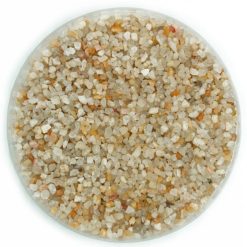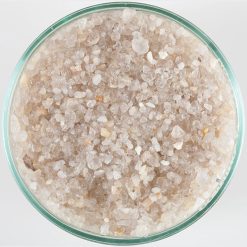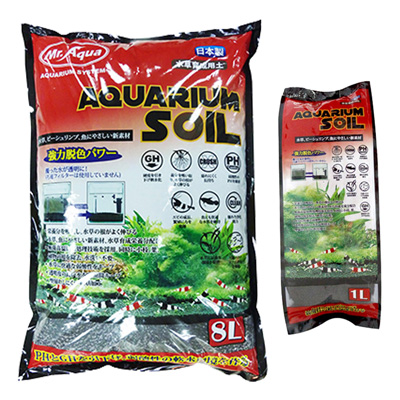Filtration, Planted Tank Basics, Solution
3D Solution The Four Basic Components of an Aquascape “Nature” Aquarium: Substrate Soil
1 Filtration – 2 Carbon Dioxide (CO2) – 3 Bright Light – 4 Substrate
Substrate
The roots of most plants only thrive in clay-based soil substrate. Sand and gravel should only be used for decoration and on top of a base layer of plant substrate. Using both general plant soil substrate and base layer fertilizing substrate plays a crucial role in biological filtration. This is more important than many people think.
Clay soil, the best from Japan, is derived from andosol or old volcanic soil. Do not confuse these with substrates or soils used for house or garden plants. We know forums etc., have all kinds of solutions using potting soil. This is too important, and buying the proper substrate prevents many problems and disasters. Actual Aquascaping companies have spent years creating substrates just for planted aquariums. They are not all created equal but non of them we have tested caused the mess or problems of the DYI formulas we have seen.
Here is an article where we tested various planted substrates. There are a lot of these on the market, and we have used most of them. aquaLife, Mr Aqua, and UP Aqua are our preferred materials for the soil layer. We use aquaLife and CaribSea products for our other decorative or non-Japanese soil plantings.
The soil of a planted aquarium consists of two to three components:
At the aquarium’s bottom is typically a plant medium with a minimum thickness of 1/2” 1 cm. The plant medium is a nutrient-rich substance; the roots of the plants come here in a dense, nutrient-rich medium. Due to the larger particle size, some of the professional plant media help with bacterial development and balance in the aquarium. An Example of this is the aquaLife Base substrate.
A minimum of ½” to ¾” 1-1.5 cm of general plant soil layer is on top of the base medium if used. This fired clay-based soil prevents the plant medium from coming into direct contact with the water column and provides ideal conditions for the roots of the plants. The roots only do well in clay-based soils; sand or gravel alone is unsuitable for plants. These sterile substrates are only used for decorative purposes in plant-based aquariums as the third layer unless a base fertilizer is used under them.
The soil of a planted aquarium plays an important role. In addition to being essential for rooting plants, it is paramount in performing biological processes. A well-assembled soil substrate for breaking down waste and decomposing ammonia is almost as important as an external filter. It has been shown countless times that an established aquarium can continue to function even after a major power outage. This is due to the excellent quality of the soil substrate – and the bacteria and plants growing in it.
Soil is essential for the overall balance of the aquarium. To give the nitrifying bacteria a suitable surface, it is necessary that the oxygen required for the bacteria be present, so the soil must remain an oxygen-rich environment. This requires a sufficiently large particle size.
Fine-grained sand alone is not suitable for aquarium soil. Tiny grains of sand impede the movement of water in the soil and are oxygen-poor. An anaerobic environment soon develops in the soil. In an anaerobic environment, the exact opposite of nitrification called denitrification will take place.
The thickness of the plant soil can vary within the aquarium to achieve the proper visual effect. Plant aquariums typically raise the substrate soil level from the front to the back, often to a level that can even reach the water surface along the back wall. Excellent quality soils are needed to prevent the grains from “rolling down.”
Lighter soil grains usually characterize inferior cheaper soils. This makes it extremely difficult to plant in them – requiring careful planting using fine plant tweezers. The soil grains do not squeeze the roots, and the plant easily comes out of the soil, or the soil cannot be effectively “hilly” as the lighter grains slip over each other and “collapse the structure.” The grains of professional soils are heavier, contain more nutrients, buffer water parameters, and are more useful for hilly aquascapes.
Better soils run out slowly. Do not worry about having to redo the aquarium in 1-2 years. A well-designed system is viable for many years. The soil can only be replanted with the complete disassembly of the aquarium, so use quality materials from the beginning.
How much soil will I need?
Calculating the amount of plant medium is simple: multiply the sides of the aquarium base in cm and divide the product by 1000. This gives the required amount of plant medium in liters. And the minimum required amount of general plant soil will be four times this value. If raising the ground backward like a hill, additional bags of soil or substrate will be needed. Top coats for effect can add beauty and help the plant’s root when appropriately selected. aquaLife Black Diamond and the CaribSea natural gravel are the best options. For substrate sold in pounds, a general guideline is 1 to 1.5 lbs per gallon of aquarium water is an approximate amount.
-
 Super Naturals Carolina Creek 20LB$25.19
Super Naturals Carolina Creek 20LB$25.19 -
 Super Naturals Carolina Creek 5LB$7.34
Super Naturals Carolina Creek 5LB$7.34 -
 Super Natural Sunset Gold Sand 20lb Premium Aquarium Substrate6 jbh$31.49
Super Natural Sunset Gold Sand 20lb Premium Aquarium Substrate6 jbh$31.49 -
 Black Diamond Substrate- 15 lbs.$27.29
Black Diamond Substrate- 15 lbs.$27.29 -
 Black Diamond Substrate – 3 lbs.$7.34
Black Diamond Substrate – 3 lbs.$7.34 -
 Super Natural Torpedo Beach Sand 20lb Premium Aquarium Substrate$30.45
Super Natural Torpedo Beach Sand 20lb Premium Aquarium Substrate$30.45
1 Filtration – 2 Carbon Dioxide (CO2) – 3 Bright Light – 4 Substrate
Next Up Solution 3 Part 2 CO2

